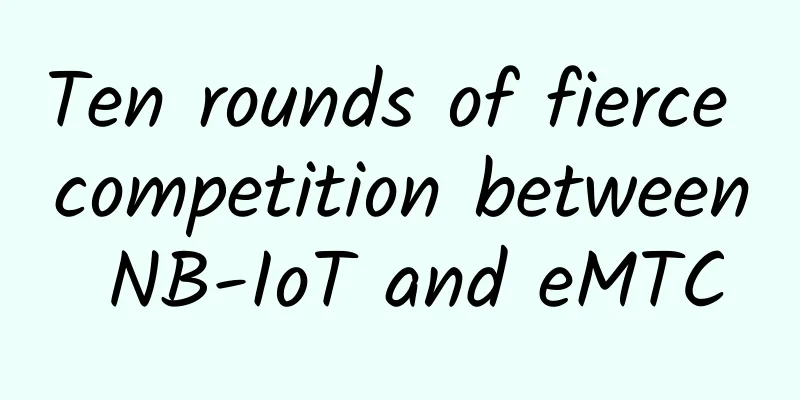Ten rounds of fierce competition between NB-IoT and eMTC

|
This article systematically sorts out and analyzes the main performance of NB-IoT and eMTC in ten aspects. After ten rounds of debate, let us re-examine what China Mobile's best decision should be. With the continuous development of mobile communication technology, the global Internet of Things is about to usher in rapid development. Among international operators, AT&T, Verizon, KDDI, KPN, Orange, NTT DoCoMo, Telefonica, Telstra, and Telus have successively launched the commercial use of eMTC.
In my country, China Telecom took the lead and after establishing the 800MHz networking capability, it planned to build 300,000 NB-IOT base stations in one go. China Unicom signed a dual exclusive agreement with Jasper and determined NB-IOT as its development direction early on. China Mobile, which first proposed the two, is wavering between NB-IoT and eMTC. The main reason for this is that the two standards have their own strengths, and China Mobile's TDD network determines the complexity of its decision-making. This article systematically sorts out and analyzes the main performance of NB-IoT and eMTC in ten aspects. After ten rounds of debate, let us re-examine what China Mobile's best decision should be. Choose a Battleground In the construction of the Internet of Things, there are many application scenarios that need to be met. So in which scenario do NB-IoT and eMTC compete? There are mainly three scenarios. Let's take a look at them one by one. IoT applications can be divided into three categories based on speed, latency, and reliability requirements: Scenario 1: Low-latency, high-reliability services. This type of service has high requirements for throughput, latency, or reliability. Its typical applications include Internet of Vehicles and telemedicine. Scenario 2: Medium-demand services. This type of service has medium or low throughput requirements. Some applications have mobility and voice requirements, and also have certain restrictions on coverage and cost. Typical services include smart home security, wearable devices, etc. Scenario 3: LPWA (Low Power Wide Area) services. The main features of LPWA services include low power consumption, low cost, low throughput, wide (deep) coverage requirements, and a huge number of terminals involved. Typical applications include meter reading, environmental monitoring, logistics, and asset tracking. Among the above services, LPWA services are the main market for global operators to compete for due to their large demand for connections. NB-IoT and eMTC also compete mainly in this battlefield. Which opponents were defeated? Which network standards did NB-IoT and EMTC defeat along the way to reach the top? Currently, there are a variety of IoT communication technologies that can carry LPWA services, such as GPRS, LTE, LoRa, Sigfox, etc., but there are the following problems: 1. The terminal battery life cannot meet the requirements. For example, the current standby time of GSM terminals (excluding services) is only about 20 days. In some typical LPWA applications such as meter reading services, the cost of replacing batteries is high, and it is inconvenient to replace batteries in some special locations such as deep wells and chimneys. 2. Unable to meet the application needs of massive terminals. A major feature of IoT terminals is that they are massive, so the network needs to be able to access a large number of users at the same time. However, the current network designed for non-IoT applications cannot meet the needs of simultaneously accessing massive terminals. 3. Inadequate network coverage in typical scenarios, such as deep wells, underground garages and other coverage blind spots, where outdoor base stations cannot achieve full coverage. 4. High cost. For enterprises deploying IoT, an important reason for choosing LPWA is the low cost of deployment. The mainstream communication technology for smart home applications is WiFi. Although the price of WiFi modules is relatively low, having dropped to less than RMB 10, IoT devices that support WiFi usually still require wireless routers or wireless APs for network access, or can only communicate in a local area network. The deployment cost of cellular communication technology is too high for enterprises. The most common domestic 2G communication modules are generally more than RMB 30, while 4G communication modules cost more than RMB 200. 5. The transmission interference is large. This is mainly aimed at non-cellular Internet of Things technologies, which are based on unlicensed spectrum transmission, have large transmission interference, poor security, and cannot ensure reliable transmission. The above-mentioned points have become factors that hinder the development of LPWA services. Compared with these standards, NB-IoT and EMTC have obvious advantages. Ten rounds of fierce competition between NB-IoT and eMTC 1. Coverage NB-IOT: The design goal is to enhance coverage by 20dB based on GSM. Taking 144 dB as the maximum coupling path loss of GSM, the maximum coupling path loss designed for NB-IoT is 164 dB. Among them, its downlink mainly relies on increasing the maximum retransmission times of each channel to increase coverage. And through its uplink coverage enhancement technology, although the uplink transmission power of NB-IoT terminals (23 dBm) is 10 dB lower than that of GSM (33 dBm), its narrowing of transmission bandwidth and the increase in the maximum repetition times enable its uplink to work under the maximum path loss of 164 dB. eMTC: Its design goal is to enhance the maximum path loss of LTE (140 dB) by about 15 dB, and the maximum coupled path loss can reach 155 dB. The coverage enhancement of this technology mainly relies on channel repetition, and its coverage is about 9dB worse than that of NB-IoT. In summary, the coverage radius of NB-IoT is about 4 times that of GSM/LTE, and the coverage radius of eMTC is about 3 times that of GSM/LTE. The coverage radius of NB-IoT is 30% larger than that of eMTC. NB-IoT and eMTC coverage enhancement can be used to improve the depth coverage capability of IoT terminals, improve network coverage, or reduce site density to reduce network costs. 2. Power consumption Since most IoT applications have the problem of terminals being difficult to update due to geographical location or cost reasons, power consumption plays a very important role in whether IoT terminals can be commercially used in special scenarios. NB-IoT: The terminal battery life design target in the 3GPP standard is 10 years. In actual design, NB-IoT introduces power-saving modes such as eDRX and PSM to reduce power consumption. This technology uses multiple solutions such as reducing the peak-to-average ratio to improve the efficiency of the power amplifier (PA), reducing periodic measurements, and supporting only a single process to improve battery efficiency, so as to achieve the design expectation of 10 years of life. However, in actual applications, the battery life of NB-IoT is closely related to the specific business model and the coverage range of the terminal. eMTC: In an ideal scenario, the battery life is expected to reach 10 years. Its terminals also introduce two power-saving modes: PSM and eDRX. However, the actual performance still needs to be further evaluated and verified in different scenarios. 3. Module cost NB-IoT: It uses a simpler modulation and demodulation encoding method to reduce the requirements of memory and processors; it uses a half-duplex method, does not require a duplexer, reduces out-of-band and blocking indicators, and other methods. Under the current market scale, its module cost can reach less than US$5. With the expansion of the market scale in the future, the scale effect may further reduce its module cost. The specific amount and time schedule depend on the speed of industrial development. eMTC: Based on LTE, it also optimizes the cost to a certain extent for IoT application needs. In the initial market scale, its module cost can be less than US$10. 4. Number of connections The number of connections is a key factor in the large-scale application of the Internet of Things. NB-IoT: The goal set at the beginning of its design was 50,000 connections/cell. According to initial calculations and evaluations, the current version can basically meet the requirements. However, whether this design goal can be achieved depends on factors such as the business model of each NB-IoT terminal in the cell, which requires further testing and evaluation. eMTC: Its number of connections is not optimized specifically for IoT applications. It is currently expected that its number of connections will be smaller than that of NB-IoT technology. Its specific performance requires further testing and evaluation. 5. Further enhancements are needed Positioning function: In the R13 version of NB-IoT technology, in order to reduce the power consumption of the terminal, PRS and SRS were not designed during system design. Therefore, currently NB-IoT can only be positioned through the E-CID method on the base station side, with a relatively coarse accuracy. Of course, in future upgrades, features and designs that enhance positioning accuracy will be further considered. Multicast function: In IoT services, base stations may need to send the same data packets to a large number of terminals at the same time. In the R13 version of NB-IoT, there is no corresponding multicast service. When performing such services, the corresponding data needs to be sent to each terminal one by one, wasting a lot of system resources and prolonging the overall information transmission time. In the R14 version, it is possible to consider the multicast feature to improve related performance. Mobility/business continuity enhancements: NB-IoT in R13 is mainly designed and optimized for stationary/low-speed users. It does not support neighboring cell measurement reporting, so it is not possible to perform connected cell switching, and only supports idle cell reselection. The R14 stage will enhance the UE measurement reporting function and support connected cell switching. 6. Voice support capability For standard definition and high definition VoIP voice, the voice rates are 12.2kbps and 23.85 kbps respectively. That is, the entire network needs to provide at least 10.6 kbps and 17.7 kbps application layer rates to support standard definition and high definition VoIP voice. NB-IoT: Its peak uplink and downlink throughput rates are only 67 kbps and 30 kbps, so it cannot support voice functions in a networking environment. eMTC: The uplink and downlink rates of its FDD mode can basically meet the needs of voice. However, from an industry perspective, support is currently limited. For the eMTC TDD mode, due to the limited number of uplink resources, its voice support capability is weaker than that of the eMTC FDD mode. 7. Mobility Management NB-IoT: In R13, it is not possible to perform cell switching or redirection in the connected state, and can only perform cell reselection in the idle state. In subsequent versions, the industry may propose the need for connected state mobility management in response to the needs of certain vertical industries. eMTC: Since this technology is optimized based on LTE, it can support connected cell switching. 8. Impact of network deployment on the existing network The difficulty of network deployment and the cost of network construction are probably the most important considerations for operators in the decision-making process. NB-IOT: For operators that have not deployed LTE FDD, the deployment of NB-IOT is closer to the deployment of a new network, which will involve the construction or transformation of the wireless network and core network and the adjustment of the transmission structure. At the same time, if there is no idle spectrum, the existing network spectrum (usually GSM) needs to be adjusted (Standalone mode). Therefore, the implementation cost is relatively high. For operators that have deployed LTE FDD, the deployment of NB-IoT can largely utilize existing equipment and spectrum, and its deployment is relatively simple. However, no matter which standard is used for construction, it is necessary to independently deploy the core network or upgrade the existing network equipment. eMTC: If the 4G network has been deployed on the existing network, the eMTC network can be deployed on this basis. In terms of the wireless network, software upgrades can be performed based on the existing 4G network. In terms of the core network, this can also be achieved through software upgrades. 9. Business Model NB-IoT: It has superior performance in terms of coverage, power consumption, cost, number of connections, etc., but cannot meet the requirements of mobility, medium-speed, voice and other services. It is more suitable for LPWA applications with low speed and relatively low mobility requirements. eMTC: It is currently weaker than NB-IoT in terms of coverage and module cost, but it has advantages in peak rate, mobility, and voice capabilities. It is suitable for IoT application scenarios with medium throughput, mobility, or high voice capability requirements. Operators can choose relevant IoT technologies for deployment based on actual applications in the existing network. Therefore, some experts have always held the view that under the eMTC network, application scenarios are richer, the relationship between applications and people is more direct, and relatively speaking, its ARPU value is higher. 10. NB-IoT and eMTC performance summary Now, China Mobile's choice is crucial to the development of my country's Internet of Things industry. On the one hand, China Mobile is struggling with the uncertainty of the issuance of FDD licenses and the cost of building NB-IOT networks is much higher than that of the other two, so it has been hesitant to make up its mind. On the other hand, eMTC, which is supported by international operators, does have unique advantages, but the scale brought by the two standards has not met expectations, which will keep the prices of chips and modules high, further hindering the development of the industry. This makes it difficult for China Mobile to make a decision, because once the wrong choice is made, the opportunity cost and network cost will be huge. |
<<: Discussion on the Application of SDN in Wide Area Network
>>: WiFi is a good addition to SD-WAN, but not a must
Recommend
One skill a day: You can make a mistake in splicing a URL, and write a crawler
When writing crawlers, we often need to parse the...
Let’s talk about the four major features of 5G
From telegraphs, telephones to mobile phones, and...
Is “localization” so complicated?! In 2018, Inspur and Cisco Networks continue to demonstrate China’s strength
[51CTO.com original article] In 2017, the names o...
The benefits of 5G technology for education upgrades
With over 250 million students, India has one of ...
The results of the 14th 51CTO China Enterprise Annual Selection are out!
[51CTO.com original article] On January 6, 2020, ...
DNS communication protocol based on privacy protection technology
The Domain Name System (DNS) is an Internet basic...
Five ministries and commissions issued the "Guidelines for the Construction of the National New Generation Artificial Intelligence Standard System"
Recently, the National Standardization Administra...
80VPS: AMD Ryzen+NVMe Los Angeles Cera Data Center KVM annual payment starts at 349 yuan
80VPS is a well-established Chinese hosting compa...
5G Wireless: Market Opportunities and Technical Challenges from Sub-6 GHz to Millimeter Wave
For Massive MIMO systems, 4th Generation GaN tech...
5 Common SD-WAN Challenges and How to Address Them
Software-defined WAN is a feature-rich technology...
DiyVM: Japan/US/Hong Kong CN2 line VPS 50% off monthly payment starting from 50 yuan, Hong Kong independent server starting from 499 yuan/month
DiyVM is a Chinese hosting company founded in 200...
DogYun (Dog Cloud) offers a 100 yuan discount on all independent servers per month, and Hong Kong servers start from 300 yuan per month
DogYun is a Chinese hosting company established l...
Misunderstood 5G antennas disguised in layers - I feel bitter but cannot express it
What do you think of when you mention 5G antennas...
Analysis of SpringCloud Gateway routing configuration and positioning principles
[[409660]] Environment: springcloud Hoxton.SR11 T...
5G network construction: NSA or SA first?
Different from the era from 3G to 4G, the evoluti...









